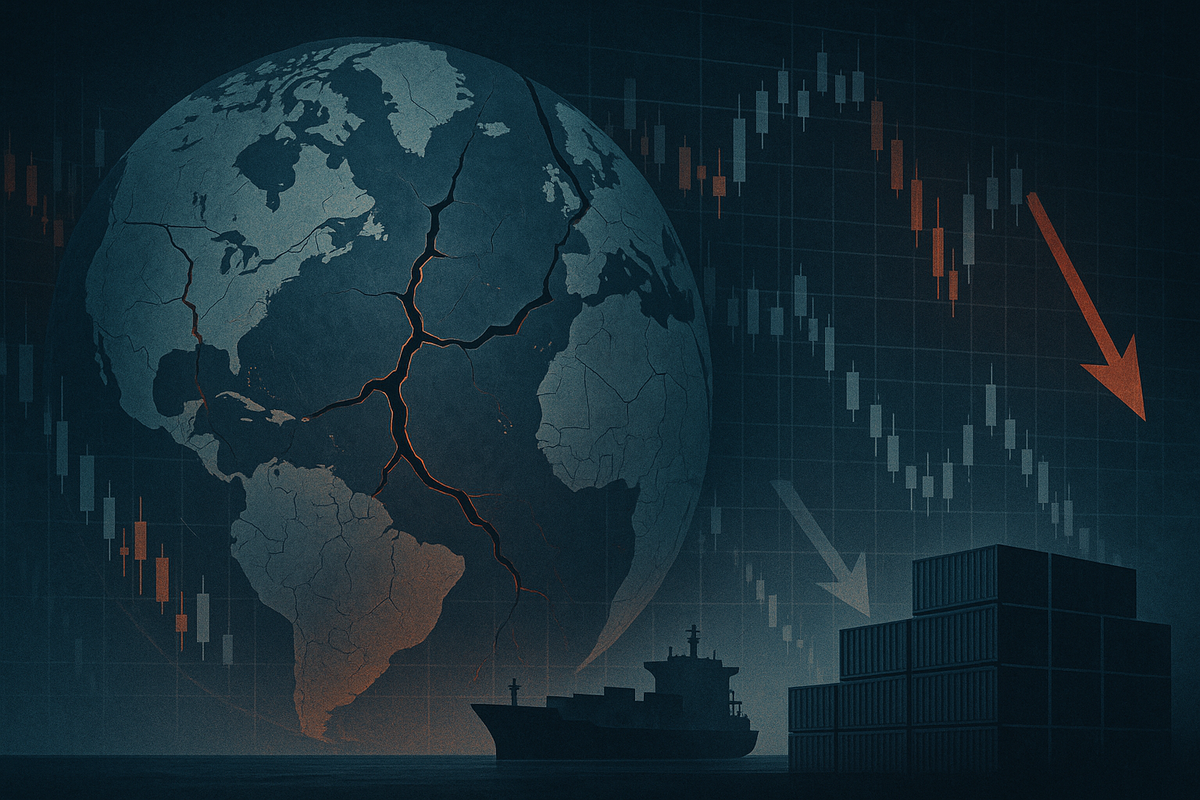
The global financial landscape is increasingly characterized by a profound and pervasive influence of geopolitical tensions, casting long shadows over market stability and investor sentiment. From ongoing military conflicts to intensifying great power rivalries and protectionist shifts, these international risks are reshaping economic trajectories, supply chains, and inflation trends worldwide. The immediate implication is a heightened state of market volatility, compelling investors and policymakers alike to navigate an unpredictable environment where geopolitical events can trigger rapid and significant shifts in asset prices and economic forecasts.
This confluence of international discord is not merely a background hum but a direct driver of financial uncertainty, complicating the already intricate dance of global monetary policy and corporate strategy. As the world grapples with a fragmented geopolitical order, the resilience of the global financial system is being tested, pushing risk aversion to the forefront and demanding a strategic re-evaluation of investment portfolios and operational frameworks.
A World in Flux: Conflicts and Rivalries Reshaping Global Finance
The current geopolitical climate is defined by several critical flashpoints, each contributing to an elevated risk premium across financial markets. The Russia-Ukraine War, now in its third year, remains a primary destabilizing force. Its onset in early 2022 immediately triggered a surge in energy and food commodity prices, fueling inflationary pressures globally and leading to significant volatility in stock and bond markets. The imposition of sweeping sanctions on Russia by Western nations has further fragmented global trade and accelerated protectionist tendencies, impacting everything from European banking equities to emerging market stocks, which saw average monthly declines of 5 percentage points during the initial stages of the conflict. The war continues to tighten global financial conditions and introduces substantial downside risks to the economic outlook.
Simultaneously, escalating tensions in the Middle East, particularly the Israel-Iran conflict and Houthi attacks on shipping in the Red Sea, pose significant threats to global energy supplies and critical trade arteries. While initial market reactions to specific engagements might be contained if perceived as limited, a wider conflict could unleash substantial negative impacts on global economic growth, especially for energy-importing economies. Historical precedents from the 1970s demonstrate how major Middle East conflicts can ignite oil price surges and rampant inflation. The Red Sea disruptions, through attacks emanating from Yemen, have already led to increased shipping costs and significant supply chain delays, impacting global logistics and consumer prices. This persistent instability erodes consumer and business confidence, potentially curtailing spending and investment.
Beyond open conflicts, the strategic rivalry between the United States and China continues to be a profound source of geopolitical risk. As the world's two largest economies, their relationship influences global trade, investment flows, and supply chains. Lingering trade tensions, including renewed tariffs, threaten trillions of dollars in global trade, with potential estimates pointing to reductions in global economic growth and increased inflation. While diplomatic efforts are ongoing to stabilize bilateral ties, the US strategy of "de-risking" seeks to reduce reliance on Chinese manufacturing in critical industries, leading to supply chain reconfigurations and increased costs for businesses like Apple (NASDAQ: AAPL) and Tesla (NASDAQ: TSLA) as they diversify production bases. The lack of robust policy coordination between Washington and Beijing remains a significant impediment to mitigating broader risks to global financial stability. These multifaceted geopolitical pressures collectively underpin the prevailing volatility and uncertainty in financial markets, forcing a constant reassessment of economic fundamentals against a backdrop of evolving international risks.
Navigating the Storm: Corporate Winners and Losers
The turbulent geopolitical landscape has created a stark divergence in fortunes for public companies and industries, driven by their exposure to commodity price shocks, supply chain disruptions, and shifting trade policies.
In the wake of the Russia-Ukraine war, the defense industry has emerged as a clear beneficiary. Increased global defense spending has translated into burgeoning order backlogs and rising stock prices for major players such as Lockheed Martin (NYSE: LMT), Raytheon Technologies (NYSE: RTX), Northrop Grumman (NYSE: NOC), and General Dynamics (NYSE: GD). Their profitability is directly bolstered by heightened government contracts as nations across Europe and beyond seek to reinforce their security. Similarly, certain segments of the energy sector, particularly oil and gas producers, reaped substantial profits as sanctions on Russia drove crude oil and natural gas prices skyward. Giants like ExxonMobil (NYSE: XOM) and Chevron (NYSE: CVX) reported record earnings, demonstrating the direct correlation between geopolitical supply shocks and commodity-linked profitability. The imperative for energy independence has also quietly boosted the renewable energy sector, with increased investor interest anticipating a faster transition away from fossil fuel reliance.
Conversely, companies heavily reliant on global supply chains or with significant operations in conflict zones have faced considerable headwinds. Ukrainian industrial sectors have been devastated, while many foreign companies with investments in Russia faced substantial write-offs and operational losses due to withdrawals or asset seizures. European energy consumers and intensive industries grappled with soaring energy prices, impacting profitability and contributing to inflationary pressures. The Red Sea disruptions have hit the automotive industry particularly hard, with companies like Volvo (STO: VOLV B), Tesla (NASDAQ: TSLA), Toyota (NYSE: TM), and Hyundai (KRX: 005380) announcing production pauses and delays due to rerouted shipments and increased costs for parts and finished vehicles. Retailers and chemical companies also face similar challenges, struggling with longer transit times and higher freight rates. While container shipping companies like Maersk (CPH: MAERSK B), MSC, and Hapag-Lloyd (ETR: HLAG) have seen short-term surges in freight rates and profitability due to constrained capacity, this comes at the expense of their customers across various industries.
The US-China rivalry has created its own set of winners and losers. US policies aimed at reshoring manufacturing and reducing reliance on China, such as the CHIPS Act, benefit domestic manufacturing and companies expanding operations within the US, like Intel (NASDAQ: INTC) and TSMC (NYSE: TSM) with their US-based fabs. However, US technology companies like NVIDIA (NASDAQ: NVDA) and Micron Technology (NASDAQ: MU) face limitations on their access to the crucial Chinese market due to export controls on advanced chip technologies. American agricultural exporters, such as soybean and cotton producers, have suffered billions in lost revenue due to Chinese retaliatory tariffs. Meanwhile, Chinese domestic brands and import-substituting industries have seen a boost as consumers shift preferences and the nation invests heavily in indigenous technological innovation to overcome foreign restrictions.
The Shifting Sands of Global Commerce: Industry Impact and Broader Implications
The persistent drumbeat of geopolitical tensions is not merely creating short-term market fluctuations but is fundamentally reshaping industrial landscapes and global economic paradigms. The ongoing conflicts and strategic rivalries are accelerating a significant trend towards de-globalization and economic fragmentation. Industries that once thrived on seamless cross-border supply chains and unrestricted trade are now facing pressures to regionalize or reshore production. This pivot is evident in the technology sector, where the US-China rivalry has spurred efforts to build more resilient and geographically diversified semiconductor supply chains, as seen with companies like Taiwan Semiconductor Manufacturing Company (NYSE: TSM) investing heavily in US-based fabrication plants. This trend translates into higher production costs and increased lead times, but also potentially more secure and diversified supply sources in the long run.
The ripple effects of these tensions are profound, extending beyond immediate combat zones or directly sanctioned entities. Energy-intensive industries, for instance, in Europe, have faced unprecedented operating costs due to the Russia-Ukraine war's impact on natural gas supplies, leading to reduced production or even closures for some smaller players. This has created a competitive disadvantage for European manufacturers compared to their counterparts in regions with more stable and affordable energy. Similarly, disruptions in the Red Sea have sent shockwaves through the global shipping industry, forcing major carriers like Maersk (CPH: MAERSK B) and Hapag-Lloyd (ETR: HLAG) to reroute vessels, adding weeks to transit times and significantly inflating freight costs. These costs are ultimately absorbed by consumers or passed on through higher prices for goods ranging from automotive parts to consumer electronics, impacting the profitability of countless companies like Volvo (STO: VOLV B) and Tesla (NASDAQ: TSLA), which have reported production delays. Competitors with more diversified logistics or regional production capabilities may gain a strategic advantage in such an environment, while partners in affected supply chains may face renegotiated contracts or the imperative to find alternative collaborations.
From a regulatory and policy standpoint, governments are increasingly adopting protectionist measures and industrial policies aimed at bolstering domestic capabilities and reducing reliance on potential adversaries. The US CHIPS and Science Act, for example, is a direct response to geopolitical competition, offering billions in subsidies for domestic semiconductor manufacturing. While such policies aim to enhance national security and economic resilience, they also risk fragmenting global markets further, potentially leading to less efficient resource allocation and retaliatory measures from other nations. The expansion of export controls on advanced technology by the US government, affecting companies like NVIDIA (NASDAQ: NVDA) and Micron Technology (NASDAQ: MU) by limiting their access to the Chinese market, underscores how economic decisions are deeply intertwined with national security objectives, altering the calculus for international business and investment.
Historically, similar periods of geopolitical strain, such as the 1970s oil shocks and the Cold War, offer valuable precedents. The oil crises demonstrated how regional instability could rapidly translate into global economic crises through commodity price volatility and supply disruptions. The Cold War showcased how ideological and geopolitical divides could lead to the formation of economic blocs, trade restrictions, and an arms race that diverted significant resources. While the specific events are unique, the underlying mechanisms of impact—commodity price shocks, supply chain disruptions, and increased defense spending—have historical parallels that inform our understanding of the broader implications. This paradigm shift compels industries to re-evaluate their entire global footprint, from sourcing raw materials to final distribution, under an ever-present geopolitical risk calculus.
What Comes Next: Navigating an Unsettled Future
The trajectory of global financial stability will remain inextricably linked to the evolving geopolitical landscape for the foreseeable future. Experts largely foresee an "unsettled" and "turbulent" global outlook for the next two to ten years, characterized by persistent volatility and a gradual erosion of the traditional international rules-based order.
In the short term, markets will continue to experience heightened volatility driven by any escalation in existing conflicts or the emergence of new flashpoints. Supply chain disruptions, particularly those impacting critical commodities and components, will likely persist, fueling inflationary pressures globally. For businesses, the imperative is strategic adaptation: diversifying supply bases across multiple regions, investing in real-time supply chain visibility and agility, and exploring localization or regionalization of operations. Companies like Framework, which champion modular and repairable electronics, exemplify a potential strategic pivot towards more resilient and less globally dependent production models. Governments, in turn, will focus on rebalancing fiscal priorities, potentially increasing defense spending, and strengthening regulatory frameworks to manage geopolitical risks within financial institutions.
Looking further ahead, the long-term possibilities point towards increased economic and financial fragmentation, with the potential for distinct economic blocs to form—a "Western-aligned" versus "China-aligned" world. This could lead to a sustained reconfiguration of global trade relationships, a continued push for energy independence (accelerating investment in renewable energy technologies), and ongoing efforts to reduce dependencies on politically volatile regions. Market opportunities may emerge in new trade corridors, in sectors driving the green transition, and in areas of technological advancement where nations are vying for leadership, such as 5G and AI. However, significant challenges remain, including persistent inflation, slower global growth, and heightened financial instability, particularly in emerging markets susceptible to capital flow reversals. Businesses that proactively integrate geopolitical risk into their strategic planning and prioritize resilience and diversification will be best positioned to navigate these complex scenarios.
The Enduring Impact: A Call for Strategic Foresight
The current era of pervasive geopolitical tension marks a significant turning point for global finance and corporate strategy. The illusion of a seamlessly interconnected world has been shattered, replaced by the reality of a fragmented and risk-laden economic environment. The key takeaway from these events is the undeniable interconnectedness of geopolitics and economics; political instability in one region can trigger a cascade of financial and operational challenges worldwide.
Moving forward, the global market will likely be characterized by a higher risk premium for international operations and supply chains. Investors should expect continued volatility and a re-evaluation of traditional asset allocation strategies, with safe-haven assets potentially offering more consistent appeal. Companies must prioritize building resilient supply chains, embracing regionalization, and embedding robust geopolitical risk assessments into every layer of their strategic planning. This includes diversifying manufacturing footprints (e.g., Apple (NASDAQ: AAPL) exploring production in India and Vietnam), securing critical raw material supplies, and fostering strong government relations in key operating regions.
In the coming months and years, investors should closely watch several indicators: the trajectory of commodity prices (especially oil and gas), the evolution of US-China trade and technology policies, the stability of critical maritime trade routes, and the fiscal responses of governments to increased defense spending and economic nationalism. The ability of central banks to manage inflation amidst supply-side shocks will also be paramount. Ultimately, the lasting impact will be a more localized, resilient, and politically conscious global economy, demanding greater strategic foresight and adaptability from all market participants.








